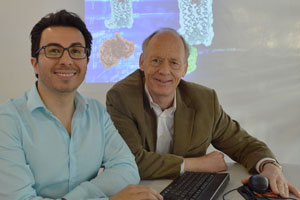17 June 2016
The mixed messages behind why some diabetic drugs don’t always work

Dr Juan Carlos Mobarec and Professor Chris Reynolds
Designing more effective medicines to treat Type 2 diabetes with fewer side-effects is a step closer thanks to an international research project involving the University of Essex.
The study, published in the prestigious international journal Cell, gives a greater understanding about how some diabetic drugs work at a molecular level and, more importantly, identifying how they can give mixed or biased messages. Understanding the origin of these mixed messages can lead to better medicines.
Essex has many years of expertise in computational modelling and used these skills to carry out 3D computer-based simulations of the drugs in action to better understand the intricacies of how they work at the molecular level.
The research collaboration, initiated by Dr Denise Wootten and Professor Patrick Sexton at Monash University in Australia and involving Professor Larry Miller at the Mayo Clinic in the United States, identified that the chemical message from the drug – in this case to decrease levels of glucose in the blood – sometimes gave more than one meaning to the cell.
Professor Chris Reynolds, from the University of Essex, who led the computational modelling, along with Drs Juan Carlos Mobarec and Kevin Smith, said: “We are filling a scientific gap in the understanding of how these therapies work and our findings could have huge implications for the design of better medicines to treat Type 2 diabetes with fewer side-effects.”
“This mechanism where we identified more than one meaning is being communicated can partially explain why some drugs have side-effects,” added Dr Mobarec, a Senior Research Officer in Computational Chemistry. “We want to understand precisely how this communication system works, so that there are only clean messages delivered into the cells.”
Diabetes currently affects around 422 million people worldwide, a number that is increasing year-on-year due to growing levels of obesity.
Type 2 diabetes, or adult-onset diabetes, usually appears in people over the age of 40 and occurs when the body fails to respond to insulin, a peptide that controls the levels of sugars in the blood.
The molecular details of how some current anti-diabetic drugs work is not absolutely clear, and the research being done at Essex is helping to clarify the mechanism of how these and other anti-diabetic drugs work at the molecular level.
The computer simulations at Essex compliment conventional testing in a laboratory setting because they can speed up the research and also can give answers that are too difficult to be reached with conventional experiments.
“That’s the extra edge that scientists gain by working with us at Essex,” added Dr Mobarec, “so that together we can reach a unique understanding of the cellular communication system. We are glad that our multidisciplinary collaboration is being showcased in the prestigious scientific journal, Cell.”
Further research is now needed in this area to further understand the communication channels at a molecular level to be able to create cleaner drugs with a lower chance of complications.
...more news releases